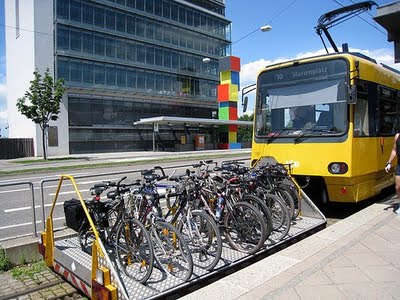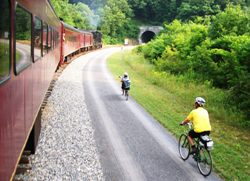Motorway: Think on
The agency has said what it thinks.

Flatcar of the Future: This stunningly simple Stuttgart system for making urban cycling viable is perfectly suited to rural ‘rail with trail’ infrastructure. photograph Burke Sisco
Headed ‘What we think’, the New Zealand Transport Agency a month ago outlined its broad plans for a Pūhoi–Wellsford motorway, and invited feedback.
Since then, the Mahurangi Magazine has published seven pieces on the proposed Pūhoi–Wellsford motorway. Readership rates, for the first time since the magazine went online three years ago, equal Januarys’—which is when waves of Auckland yachtsmen hit the site, hungry for information on the Mahurangi Regatta.
So by now the editorial stance of this publication is plain: For the sake of the harbourscape, if a motorway is built there should be no direct private vehicle access. But in any event, Aotearoa needs infrastructure for the future, not the past, and the Mahurangi needs better landscape protection.
While it has focussed on present and potential growth pressure resulting from motorway access, the magazine has consciously neglected a critical collateral issue: Sediment generation. Motorway construction would unavoidably add to the harbour’s already elevated sediment accumulation rate. And if direct access were to be provided, the ensuing development would further add to that impact.
The transport agency has extended the first consultation phase, due to close yesterday, by a week. The Mahurangi Magazine is taking the opportunity to invite readers to contribute to its submission:
Draft submission
Passing to the west of Warkworth and to the east of Wellsford
Bypasses, rather than continuous motorway or expressway, should be built around Warkworth and Wellsford—Warkworth’s could have been built already, rather than the extravagantly non-strategic four-laning currently nearing completion.
Warkworth should be bypassed to the west for the reasons the agency has cited: To avoid additional length and the need to cross the Mahurangi River. In addition to a river crossing, an eastern bypass would need to traverse steep terrain and would have a major aesthetic impact on the Wilson Cement Works heritage area.
While Wellsford is beyond the mandate of the Mahurangi Magazine, most with affection for the place and its people must have reflected on how singularly the highway defines the town as an impediment to travellers, rather than as a refreshing place to break a journey.
Tellingly, the railway passes to the east of Wellsford—the natural side on which a bypass should be built.
The advantages/disadvantages of an access point to the north or west of Warkworth and to the east of Wellsford
Bypasses, rather than continuous motorway or expressway should be built around Warkworth and Wellsford.
The benefit of bypasses, over motorway, is that full interchanges can be avoided. This facilitates access ways that more naturally integrate the towns’ roads. Travellers can detour through towns, and potentially stop for refreshment. The single access and egress demanded by motorways, discourages travellers from visiting towns that would other be natural places to break a journey. The artificial wayside food and fuel stops offer only an impoverished option and provide little to refresh the minds of drivers.
If a motorway is built beside Warkworth, the access should be to the north so as to relieve town roads of traffic to and from Goat Island, Leigh, Matakana Ōmaha and the Mahurangi peninsula. Warkworth’s ability to attract visitors is currently seriously compromised.
Holiday travellers crawling through Warkworth are understandably reluctant relinquish their place in the queue to detour into the town, and face a lengthy wait to rejoin the highway. Access from a motorway will increase the attractiveness of Warkworth to visitors, but for reasons that will be expanded further a motorway should not be built.
Wellsford similarly would benefit from a bypass designed to entice travellers to break their journeys, rather than to grit teeth endure the delay to their progress.
Any other matters you think should be thought about in the overall design of the new highway
The raison d’être for the Mahurangi Magazine is the Mahurangi landscape: A harbourscape of outstanding natural beauty, a million miles from the metropolis.

Rail Trail of the Future: Increasingly, internationally, the move is to rail with trail, rather than cannibalise perfectly useable railways. photograph Rails-to-Trails Conservancy
The need for better protection from development impacts is manifest from the erosion of the rural look and feel of the scenic Mahurangi West ridge road. Concern for the added impact arising from the completion of the motorway to the Pūhoi River has been articulated for some time and was a driver for, and has been included in, the Mahurangi Action Plan.
To date, the development impact has been softened by the global economic downturn.
The greatest protection for the harbourscape, is the status quo: That it remains signalled that the motorway will be extended north of the Mahurangi West Road, and for there to be no direct access to it from Mahurangi West and Pūhoi. This does not obviate the need for more specific landscape protection, as recorded in the Mahurangi Action Plan.
The Mahurangi Magazine, however, cannot in good conscience advocate for further motorway extension, despite it being conducive to reducing local development pressure.
Anthropogenic global warming dictates that every practicable measure must be taken to reduce carbon dioxide emission. The singular means of achieving this to discourage daily long-distance commuting, and to regulate for moving freight by rail.
Global warming, aside from its threat to global security, is forecast to bring more severe and more frequent drought, and more severe and more frequent deluges to Auckland and Northland. Urgent mitigation is both a moral and practical imperative.
The economies of the communities between Pūhoi and Wellsford, and in Northland, will ultimately be more resilient if based on a low-carbon infrastructure, rather than be encouraged to increasing rely on fossil or bio fuel.
If the motorway is extended northward, bus bays should be provided at Mahurangi West, but otherwise private vehicle access should be via the existing highway. This should probably also be the case at Pūhoi, although one reader suggests that something less than a full interchange might provide ‘a middle ground’.
Clearly, further improvements are needed to State Highway 1. An example in the Mahurangi catchment is where the two-lane Pohuehue viaduct substantially diminishes the utility of the passing lanes, while multiplying the hazard.
To summarise, the Mahurangi Magazine urges the agency to build infrastructure for the future, not a fossil fuel –hungry highway from the past.
Spend the $2.3 billion on rail with trail.
